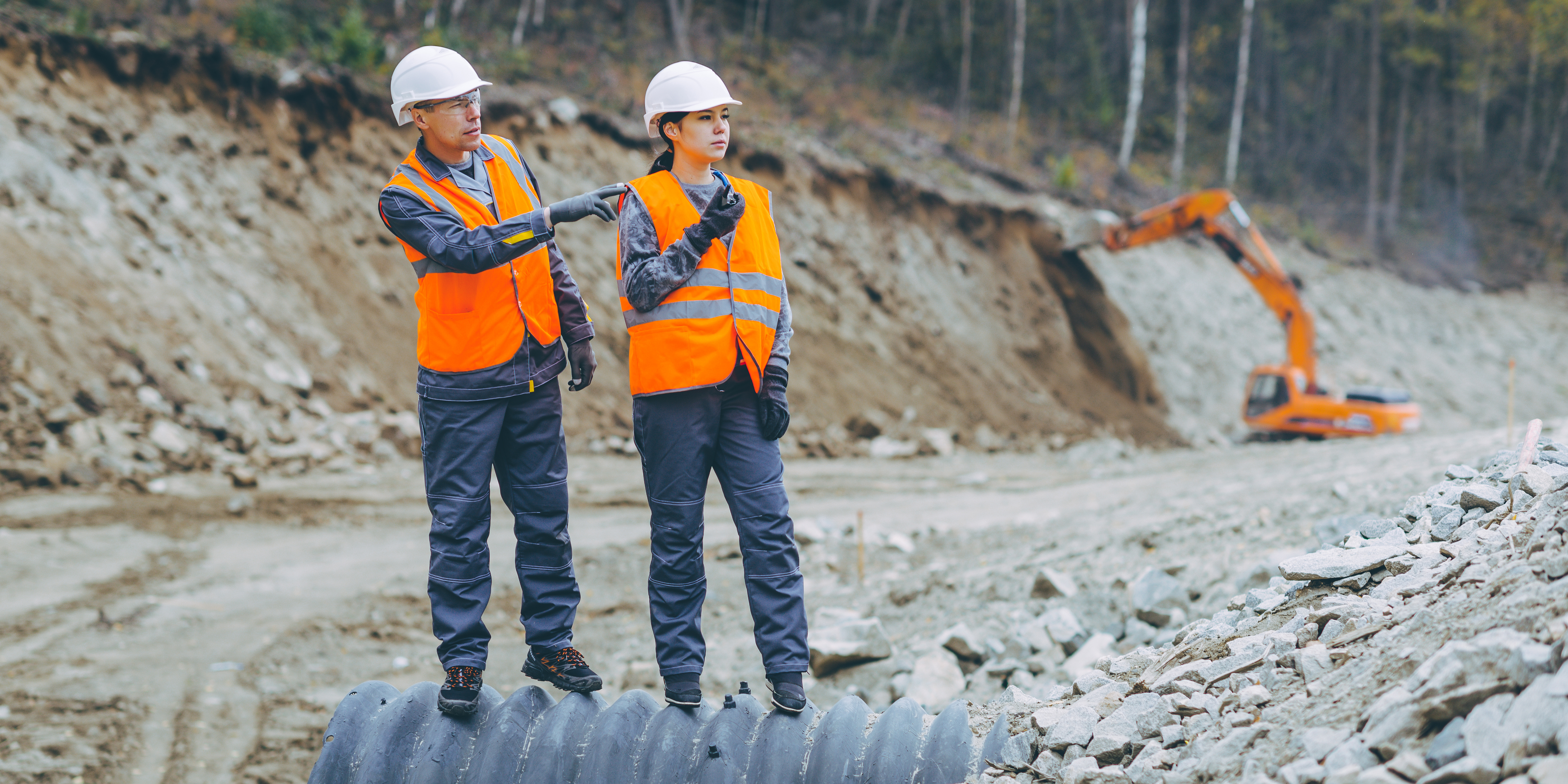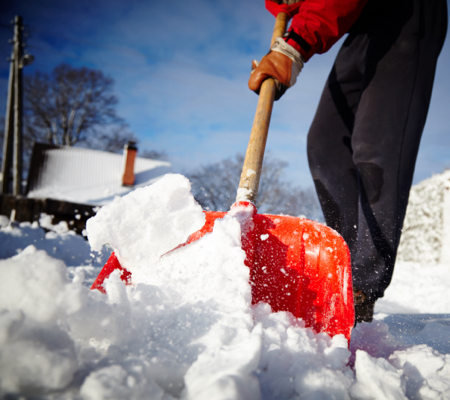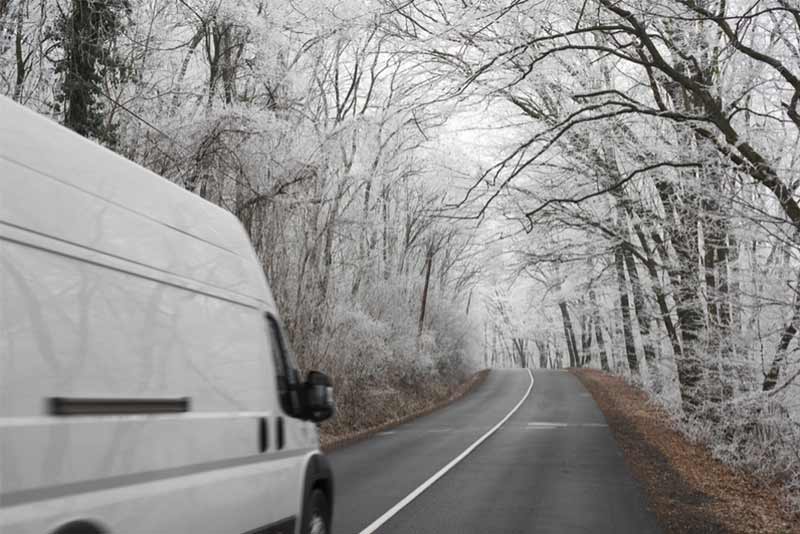How to keep staff safe this winter

While employee health and safety is no doubt always at the top of your agenda, winter brings a new set of challenges.
Shorter days, wetter weather, plummeting temperatures, ice and snow; are all liable to test just how ready your organisation is for the winter months. Not only does inclement weather pose additional risks to outdoor workers such as those in construction, aggregates and the wider industrial sector, it can also cause severe disruption. And with this winter forecast to be the coldest in a decade, labelled a ‘mini ice-age’, you need to be at the top of your game.
What are the health and safety risks in winter?
Risks to be mitigated against in winter range from slips, trips and falls caused by walking on icy paths and wet surfaces to cold stress caused by exposure to low temperatures and adverse weather conditions as well as hazards created by low-light levels. This includes the risk of accidents such as being hit by falling objects, traffic collisions, and employees not being seen by machinery and vehicle operators. And of course each winter we also have the risk of bugs and viruses circulating including colds, flu and, this year the highly contagious COVID-19. As an employer, organisations have a responsibility to take precautions to protect employees. This holds true in every weather condition so it’s time to make sure you’re prepared for winter.
At phs Besafe, we are the leading supplier of high-quality, effective and hard-working workwear in the country alongside our commercial laundry services. We’ve worked with organisations across every sector overcoming even the most unique and difficult challenges. We keep employees safe day in, day out, and our reason for being is to help you. With this in mind, we’ve prepared the following advice on some of the key considerations which need to be on your radar this winter
Regularly assess your working environments
When it comes to health and safety, it is essential to review your organisation’s operations and potential risks every winter. Understanding the conditions employees have to work in while undertaking a risk assessment lays the groundwork for you to plan for any eventuality, identifying any possible issues and take mitigating action early.
Make it your business to really get under the skin of what your employees deal with on a daily basis and the impact of changing environmental conditions. This means spending time with staff, speaking to them and having an open door to encourage people to raise any potential issues knowing that they’ll be listened to. This shouldn’t be a one-off exercise; reviews must be regular to ensure they evolve to changing conditions and needs, learning from experience and adopting best practice.

Adhering to regulation
The Health & Safety Executive (HSE) dictates that under health and safety law, all workers have the right to work in places where risks to their health and safety are properly controlled, and employers have a legal and moral obligation to protect the health, safety and wellbeing of staff and any visitors to their business premises. HSE also brings attention to the fact that winter creates additional hazards due to exposure to cold temperatures as well as risks caused by of leaves, ice and snow. Employers must consider and properly manage these risks.
A variable issue is maintaining workplace temperatures. In the UK, the Approved Code of Practice recommends a minimum temperature threshold of 16C for indoor workplaces, lowering to 13C if workers are exerting rigorous physical effort. There is no set minimum for outdoor working but employers should complete a risk assessment to determine if it’s too cold for outdoor workers, accounting for the wind chill factor. Asking employees to work in extreme cold could constitute a breach of duty of care.
Preventing cold stress
When exposed to extreme cold weather or spending a prolonged period of time in temperatures under 12C or adverse conditions, staff are at risk from suffering cold stress. This includes chilblains from repeated exposure to cold and hot temperatures, trench foot from prolonged exposure to wet and cold conditions, frostbite resulting from reduced blood flow due to exposed body parts freezing and, in some cases, hypothermia where the body loses heat faster than it can be produced.
To prevent cold stress and cold-related illnesses from affecting outdoor workers, you should schedule work to be completed during the warmest parts of the day and ensure they don’t work outside during times when extremely cold temperatures and adverse conditions are forecast. Additionally, ensure they are provided with protective workwear and PPE that adequately protects them from the elements. A few add-ons can make all the difference in protecting employees. For instance, at phs Besafe, our winter workwear and protective garments are insulated with elasticated cuffs and heavy-duty zips reinforced with a press stud overlap to limit wind chill effect. We also use hi-tech materials such as GOR-TEX to repel cold and precipitation. And if you’re sourcing cold weather clothes, extra protection can be provided by additional base layers, hats, non-slip insulated boots and gloves – all essential winter workwear items.
Slips, trips and falls
The most common workplace incidents are slips, trips and falls so taking steps to prevent them from occurring is an absolute must. Organise your building’s external paths to be frequently cleared of leaves, snow and ice, gritting when needed. When working outdoors, provide workers with slip-resistant or other appropriate protective footwear to reduce the risk of slipping. Inside, display a wet floor sign in areas that are likely to become slippery due to rain and wet footprints while entrance mats will help dry shoes and collect rain, leaves and other debris, preventing it being walked into your workplace.
Providing the right facilities and equipment
As an employer, you’re legally required to provide certain free facilities to staff. This includes toilets, washing facilities, drinking water, first-aid provisions along with protective clothing and equipment – ensuring it is properly looked after. For long-term security, source workwear which is made from durable, high-quality materials that offer both comfort and protection. In reduced winter daylight hours and bad weather, arm staff with effective high-visibility garments to help them see and be seen. And when it comes to laundering, choose a professional service that will preserve the waterproof and high-visibility properties of the garment, ensuring it remains fit for purpose and extending its life. At Besafe, we also inspect garments before being returned and repaired if needed.

Road accidents
Whether your workforce is commuting or need to drive as part of the job, winter brings increased risks of road accidents caused by adverse weather conditions. Heavy rain, fog and snow can make it difficult to see the road, heavy rain can cause vehicles to aquaplane and lengthen braking distances while leaves, snow and ice can create skidding risks.
Monitor weather forecasts and check conditions are appropriate for driving before arranging for your employees to set out on their journeys and take time to educate them on how to drive safely and appropriately in different weather conditions. Advanced driving courses can help upskill your workforce enabling them to better identify hazards, drive safely and respond to adverse conditions.
Combating illness
While there is no legal obligation to prevent the spread of illness in the workplace, you are obliged to protect your employees’ welfare. Lessening the risk of sickness not only keeps your staff well but also reduces the number of sick days. And in addition to coughs, colds and winter flu, COVID-19 is yet another virus to combat this winter. Go back to basics by encouraging staff to wash hands regularly as well as providing hand sanitising stations and individual sanitiser to be used anytime, anywhere. Continue to practice social distancing wherever possible, ensure mask wearing requirements are enforced and well ventilate premises and vehicles. Indoor spaces can also benefit from air purifiers which remove viruses, including cold, flu and COVID-19, from the air as well as air purification systems which are scientifically proven to kill COVID-19. Remember that workers who frequently encounter rain and cold weather conditions have a heightened risk of catching colds or the flu so keeping them warm and dry will also keep them safe and well.
Go the extra mile
Once you’ve covered the ground in terms of health and safety, going the extra mile can really help boost employee wellbeing. Simple measures such as adjustments to work routines in bad weather and poor light can make all the difference, whether it’s more frequent breaks, provision of hot drinks and additional training for driving or operating machinery in variable conditions.
Investing in additional lighting can help extend working hours past daylight and lessen poor visibility risks. If conditions become hazardous, take the bold decision to cut the working day short to protect workers. By equipping your workforce with the right equipment, workwear and procedures for all weathers as well as prioritising wellbeing, they’ll feel a valued member of the team as well as being able to comfortably and safely do their jobs.
At phs Besafe, we care about the health and safety of your employees and provide protective workwear supply and laundering services to more than 3,000 sites across the UK. To find out more about our workwear supply and rental, industrial laundering and secure garment destruction services, speak to us today.